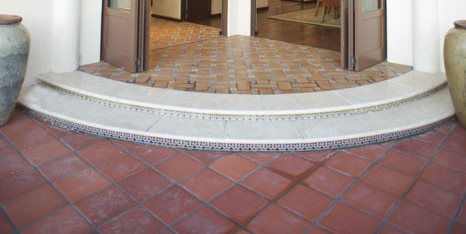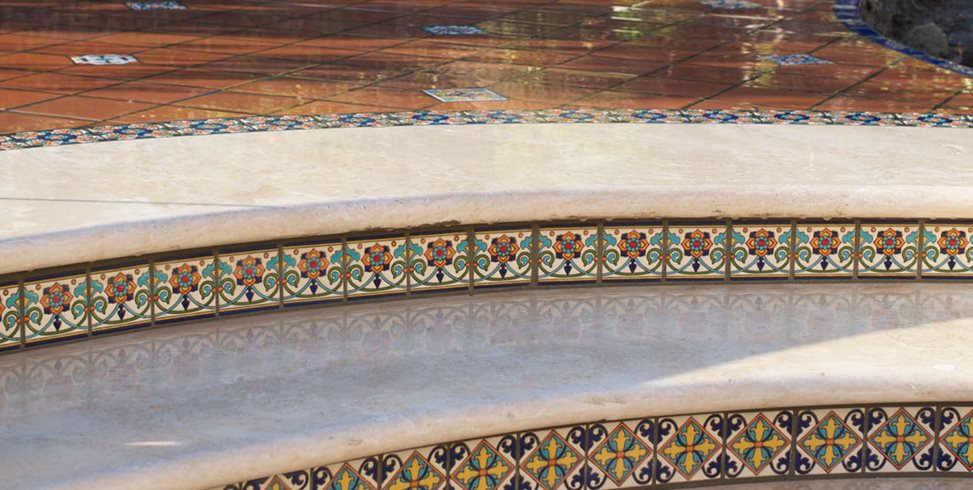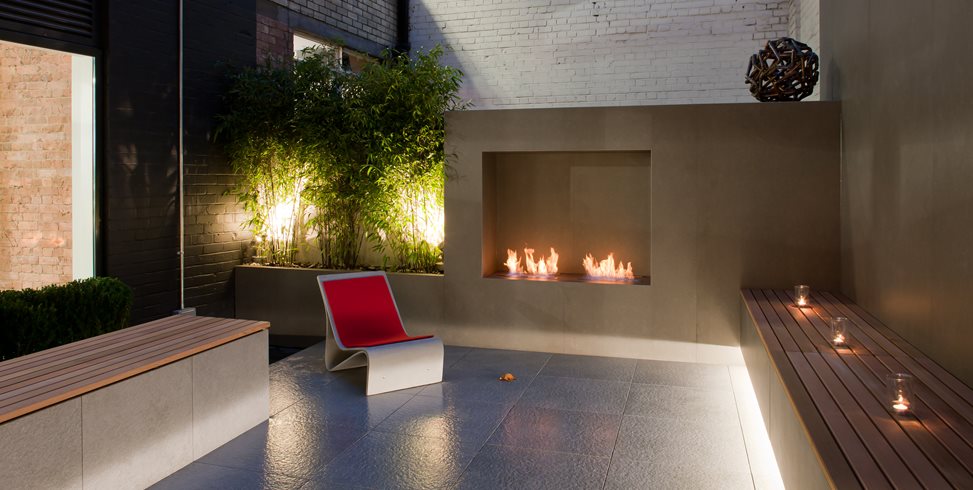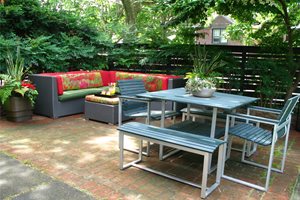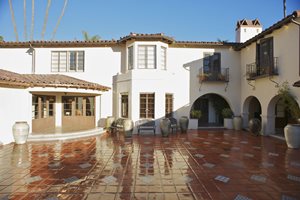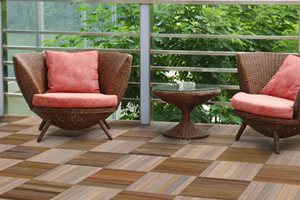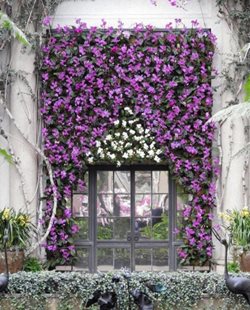Patio Tiles
Using tile to remodel an old patio or create a new one from scratchTile is the ideal way to make your outdoor living spaces truly special. Whether remodeling an old landscape or creating a new one from scratch, there are so many types of tile and manufacturers that making a final choice can be more difficult than anticipated. This is why it's important to use a landscape designer who understands tile and can guide you in selecting the right one for your unique set of criteria.
The most commonly used patio tiles are made of unglazed clay. The better fired it is the harder and more dense the result. Red clay is the most common and others of similar character may be made of white, gray and black clay.
- Pro Tip: We sell 12" by 12" red clay tile all day and all night.--Armen Alajian, Arto Brick
Glazed tiles are most often used as accents. They are laid in bands around the edges of a space or integrated with the unglazed paver into a reoccurring pattern. A newer idea called tile "carpets" are rectangular fields of patterned tiles that organize an outdoor living space just as an area rug would function in a living room.
The Question of American Made vs Imports
ARTO Brick is a California company that has produced a fine line of traditional terra cotta patio pavers in all the Old World shapes. Their floor tiles offer the rustic appeal of Saltillos with high quality materials and firing. Armen Alajian believes this family tradition is more than just manufacturing.
"We were making terra cotta pavers forever since my father immigrated from the Middle East and founded our company decades ago. We produce very durable, high fire stoneware for freeze thaw that brings back the old Roman Empire look to new projects. Our most common are what we call port town styles, which are homes with a Mediterranean, Moroccan, Italian or south of France influence. We believe softer lines are good for the brain so even our more perfect products have a hand made feel. The Spanish style works well with our line so we began producing color tiles in the California tradition. These are our tile "jewelry", and a much smaller percentage of our products."
Today ARTO employs over fifty employees. Alajian also details their extension into concrete tile during the energy crisis. "We couldn't turn kilns on any more so we tried concrete and we bought them out. Clay is double the concrete prices." But Alajian also knows that concrete or cement tiles don't hold up under the rigors of water and weather as stoneware tile, and so the use of these are not common outdoors, in freeze thaw, water features or in conjunction with swimming pools.
Patio Tile Selection Criterion
Any time tile is considered for a project, contractors and designers strive to be sure all the primary factors are addressed. These feed into many aspects of the selection process both in terms of aesthetic appeal and practical functionality.
Surface covered or not.
Every patio contains a different set of circumstances. This fully exposed to sun and weather will have far different challenges than those under waterproof cover. Many projects are a combination of both, and therefore the tile must be able to withstand the exposed conditions above all else.
Interior floors.
Outdoor spaces located adjacent to sliding or French doors create a threshold where interior flooring meets outdoor patio surfacing. For this reason, designers try to select an outdoor tile that best resembles the colors and textures of interior floors.
Kids wear and tear.
For homes that have kids and pets, golf shoes or other stressors of paving, the tile choice must be strong and resist both scratches and chips. The durability of this tile choice is paramount. It must withstand a heavy object dropped onto the surface without cracking the tile clear through. If it does chip, will contrasting internal materials become exposed or is the color the same all the way through? With glazed tile, will a chip spoil its color pattern?
Melanie Stephens of Granada Concrete Tile emphasizes the popularity of their unique tiles at thresholds. "Our tile is popular for extending indoor floors to outdoor space. The ability of using tile indoors and outdoors allows perfect flow through."
Stephens also promotes cement tiles due to their strength. "You don't use glazed tiles on the floor because it chips and cracks to reveal the clay. With cement tiles, if they chip, what you see is more same color 1/8 inch deep. We have found cement is less likely to crack than a ceramic tile. If it chips, that maintains color. We've had very few issues with cracking or repair."
Slippage.
This is the single most important feature of outdoor tile. In general glazed ceramic tiles are not particularly slip resistant, but some brands incorporate coarse sand into the glaze to make them more tactile. Slipping also relates to water, and in wet climates this is a much more serious concern. Larger grout joints do limit slippage but only if the tiles are small enough. Before accepting the fact that a tile is slip resistant, test it yourself to be sure.
Water.
When tile is used adjacent to swimming pools, spas or fountains, or within these constructions themselves, it must be able to withstand long term exposure to chemicals. Chlorine and acids used to maintain water quality can have a damaging effect on tiles not manufactured specifically to with stand this. In general, the more dense the tile the less effect chemicals will have.
Porcelain tile is considered a panacea for the typical issues of freeze thaw as well as the presence of treated water in the landscape. Federico Martin of Integrated Renovation Projects explains why this tile is growing in popularity. "Another characteristic of porcelain is how they manufacture it with a new system that allows it to look like other materials such as black slate with color and texture. Textures are made in the mold, then colored and it looks just like black slate. It's amazing how much it looks like real stone, real concrete without the problems."
"Feel" on bare feet.
For those who live in warm climates, or where tile is associated with pools and spas, there's a special consideration for bare feet. Many people have strong feelings about how a tile feels when walked on barefoot. Some that are wire cut or made to prevent slippage may not feel comfortable.
Heat absorption in hot climates.
Another hot climate factor is how well the tile will absorb heat. Dense stone tiles that are favored in the north may be impossibly hot during southern summers. More porous tiles such as Saltillo pavers earned their stripes in hot climates with a cooler walking surface. Remember that heat absorbed during the day radiates into the evening air, which may or may not be desirable.
Sleek or rustic.
This aspect is purely aesthetic but illustrates the two basic style trends today. Sleek and smooth is key to modern design. Rough and rustic, irregular and hand made is the other end of the spectrum. Start by eliminating all of those options that don't fall into one of two categories to simplify the process.
Alajian of ARTO Brick understands this rustic market. "With clay tiles we do one texture and a high fire glaze. Concrete has many textures to give it a vintage look. We call this modern American rustic. Our family is bohemians and we are oddballs and like to go against the grain in many areas of life. This tile is our jazz. It feels good and it's not a fad."

 Backyards
Backyards
 Front Yards
Front Yards
